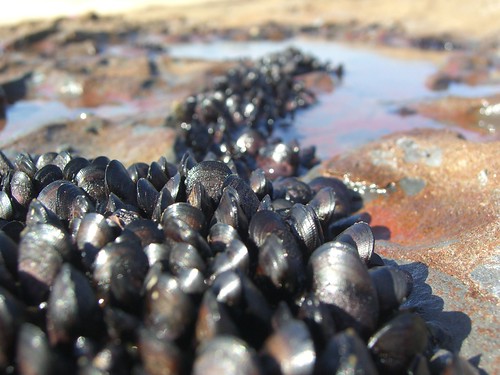 Marine mussels can adhere to virtually all inorganic and organic surfaces, sustaining their tenacious bonds in saltwater, including turbulent tidal environments.
Northwestern University's Phillip B. Messersmith has created new materials that mimic mussel adhesive proteins for three medical applications: sealants for fetal membrane repair, self-setting antibacterial hydrogels, and polymers for cancer drug delivery and thermal destruction of cancer cells.
Marine mussels can adhere to virtually all inorganic and organic surfaces, sustaining their tenacious bonds in saltwater, including turbulent tidal environments.
Northwestern University's Phillip B. Messersmith has created new materials that mimic mussel adhesive proteins for three medical applications: sealants for fetal membrane repair, self-setting antibacterial hydrogels, and polymers for cancer drug delivery and thermal destruction of cancer cells."Mussel adhesion is a remarkable process involving secretion of liquid protein glue that hardens rapidly into a solid, water-resistant adhesive," Messersmith said.
"Several aspects of this process inspire our development of synthetic materials for practical applications. An unusually compelling opportunity for translation of mussel-adhesion concepts is in the repair or reconstruction of tissues in the human body, where water is ubiquitous and its presence represents a challenge for achieving desired outcomes," he explained. Messersmith is a professor of biomedical engineering at Northwestern's McCormick School of Engineering and Applied Science. The foot of the common mussel (Mytilus edulis) produces a sticky glue for adhering to rocks and other objects. Key to its adhesiveness is a family of unique proteins called mussel adhesive proteins, which contain a high concentration of the catecholic amino acid DOPA (dihydroxyphenylalanine).
All of Messersmith's biomedical materials contain a synthetic form of DOPA. Premature rupture of fetal membranes can occur spontaneously or in association with a surgical procedure. The membranes have limited ability to heal from these ruptures, and the situation often leads to early labor, premature birth and other serious complications.
Messersmith's synthetic polymer is formulated as a rapidly solidifying liquid glue that adheres to the wet tissue and seals fetal membrane defects.
His group is collaborating with researchers in Europe to conduct in-vivo testing of their mussel-inspired medical sealants for fetal membrane repair.
Silver ions possess antibacterial activity at low concentrations, and this has led to interest in incorporating silver into medical devices.
Messersmith employs silver both to induce hydrogel cross-linking via catechol oxidation and as a precursor for silver nanoparticle formation. The silver nanoparticles then become embedded within the hydrogel structure, releasing silver ions to produce an antibacterial effect.
One of Messersmith's polymer designs forms pH-sensitive drug delivery vehicles that are stable and inactive in the bloodstream but are activated in the acidic tumor environment, which liberates the drug.
A second design involves modifying the surface of gold nanorods with a mussel-inspired polymer coating, which helps the nanorods target cancer cells. Once at the target, the nanorods are irradiated with near-infrared light to produce highly localized heating that thermally destroys cancer cells.
Messersmith will discuss his research at the American Association for the Advancement of Science (AAAS) annual meeting in Boston.
Source: News Track India
Image courtesy of avlxyz via Flickr (CC BY-SA 2.0)
